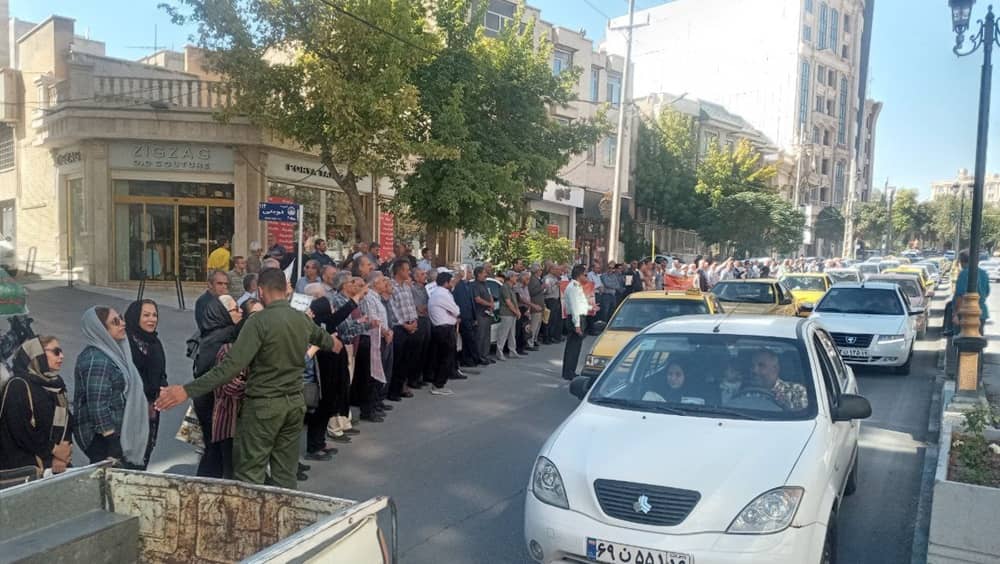Facebook
Twitter
LinkedIn
Pinterest
Reddit
Email
Print

On the first day of October 2025, a firestorm of protest swept across Iran, exposing the clerical regime’s profound systemic failures and unifying disparate segments of society in a powerful display of dissent. From university campuses ignited by deadly negligence to the militarized streets of Sistan and Baluchestan and the defiant cells of the regime’s most notorious prisons, the Iranian people are launching a multi-front challenge to a corrupt and incompetent theocracy. These are not isolated incidents but interconnected expressions of a nation’s rejection of tyranny.
Universities Erupt Against Incompetence and Repression
The nation’s universities have once again become epicenters of protest, channeling the anger of a generation robbed of its future by the regime’s lethal incompetence. On Tuesday, September 30, students at Semnan University of Medical Sciences took to the streets to protest the tragic deaths of two female classmates in a bus crash. The incident, a direct result of the university’s use of a dilapidated bus and a driver with a known poor record, was a tragedy students had repeatedly warned was inevitable. They called for the prosecution of university officials. The regime’s contempt was personified by the university’s head, Ali Rashidipour, who arrogantly refused to attend a crisis meeting, stating the students’ “tone” was not to his liking.
September 30—Tehran, Iran
Students of Khajeh Nasir University held a night rally in the dormitory courtyard to continue protesting their conditions and authorities lack of action. They chanted: “The university is our stronghold, expulsions have no effect.”#IranProtests pic.twitter.com/5RqfAJGcxo
— People’s Mojahedin Organization of Iran (PMOI/MEK) (@Mojahedineng) October 1, 2025
Simultaneously in Tehran, students at Khajeh Nasir Toosi University held nightly protests for the second consecutive evening in their dormitories. Their slogans captured the dual nature of their struggle against both political suppression and systemic corruption: “University is a fortress, expulsion has no effect!” and “No cafeteria, no dorm, but the theft continues.” These protests underscore that for Iran’s youth, the fight for basic rights and the fight against corruption are one and the same.
State-Sanctioned Violence Against Baluch People
In Sistan and Baluchestan province, the regime’s rule by fear was on full display. On September 30, armored vehicles and a massive contingent of military forces flooded the streets of Zahedan to suppress any commemoration of the third anniversary of “Bloody Friday.” On that day in 2022, regime forces, including snipers, opened fire on peaceful protesters, massacring at least 105 civilians, among them 17 children. The heavy military presence today is a testament to the regime’s fear of its own people and its reliance on brute force to maintain control.
September 30—Zahedan, southeast Iran
On the morning of September 30, marking the third anniversary of Bloody Friday in Zahedan, the streets and avenues of the city witnessed a heavy presence of military forces with armored and combat vehicles.
The atmosphere in Zahedan is highly… pic.twitter.com/Ovz3bosBZY
— People’s Mojahedin Organization of Iran (PMOI/MEK) (@Mojahedineng) September 30, 2025
This state-sanctioned violence is a daily reality for the region’s impoverished Balochi citizens. On September 27, a Baluchi fuel porter (sookhtbar) was burned alive in his vehicle after being pursued and shot at by state security forces on the Bandar Abbas-Minab road. Just a day earlier, on September 26, two other fuel porters were seriously injured when security forces opened fire on their vehicle. These are not law enforcement actions; they are acts of war against a populace struggling to survive.
Resistance from the Depths of the Regime’s Dungeons
Perhaps the most poignant display of defiance has come from within the regime’s own prisons. In a remarkable act of solidarity, female political prisoners in the notorious Qarchak Prison and male political prisoners in Evin Prison launched coordinated protests on September 29 and 30. Following the recent death of prisoner Somayeh Rashidi under suspicious circumstances, 19 women in Qarchak began a hunger strike, demanding their transfer from the inhumane conditions of the facility and the release of critically ill inmates. In response, male political prisoners in Evin held a sit-in in their prison yard, amplifying the women’s demands and demonstrating a united front against their common oppressor.
From the classrooms of Semnan, to the streets of Zahedan, to the besieged homes of Isfahan, and even the cells of Evin Prison, a single, unified message is emerging: the people of Iran have had enough. The regime is failing on every front, unable to provide basic safety, economic security, or justice. Its only recourse is the brute force that it uses against fuel porters, peaceful mourners, and protesting students alike. But as these widespread protests show, violence and oppression are no longer effective deterrents. The resilience and organized resistance of the Iranian people signal that the foundation of the clerical regime is cracking under the weight of its own corruption and brutality.